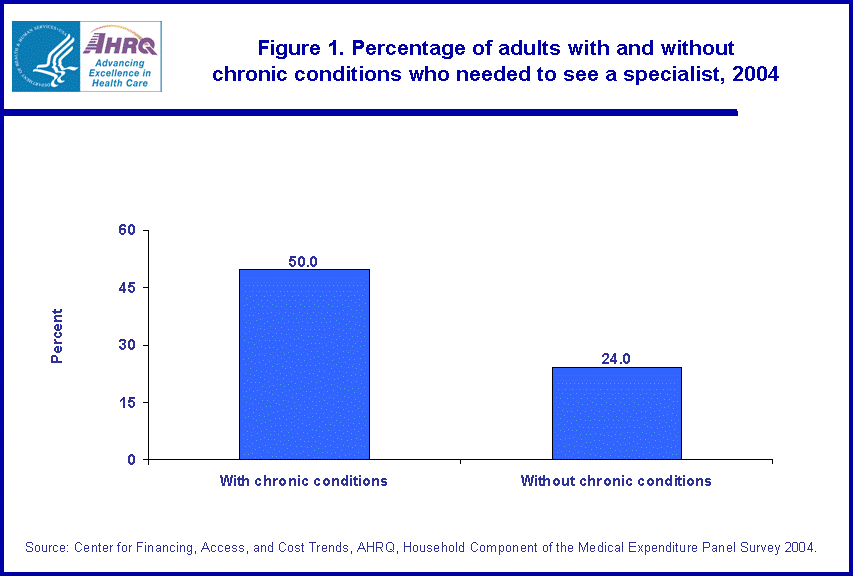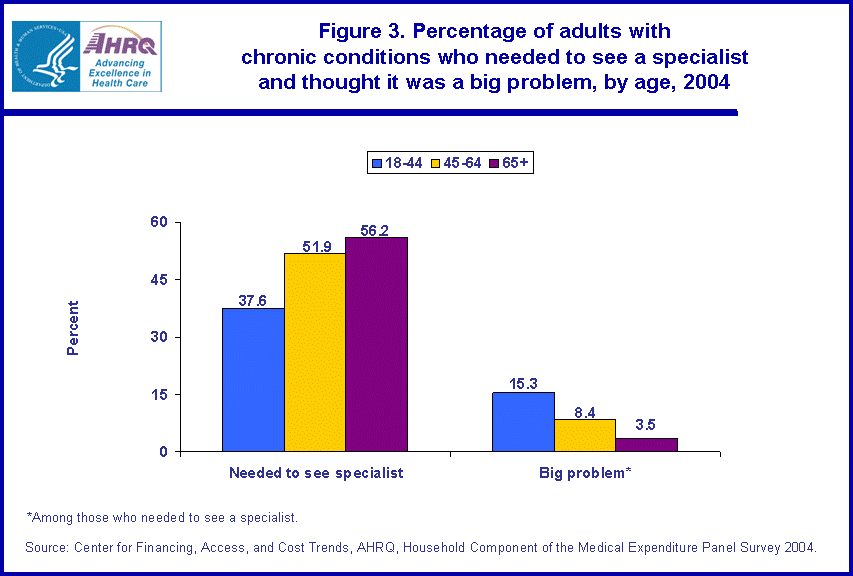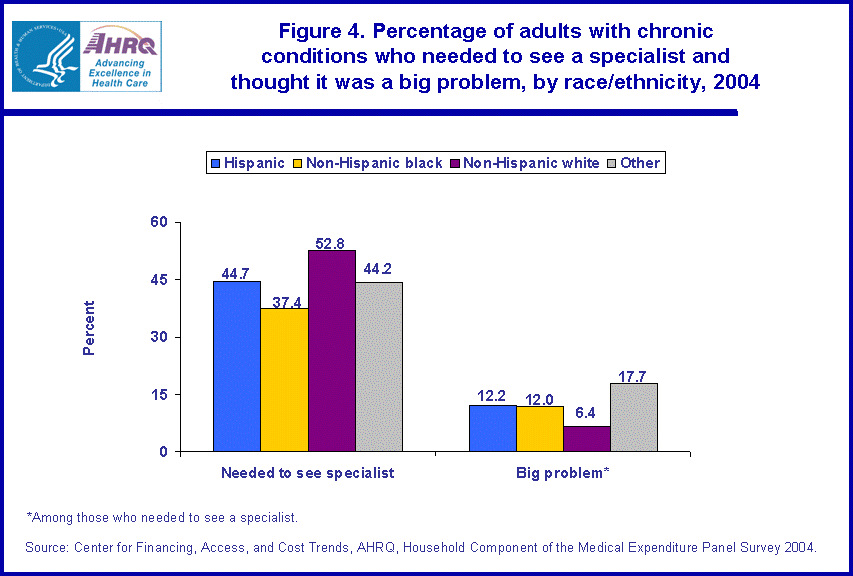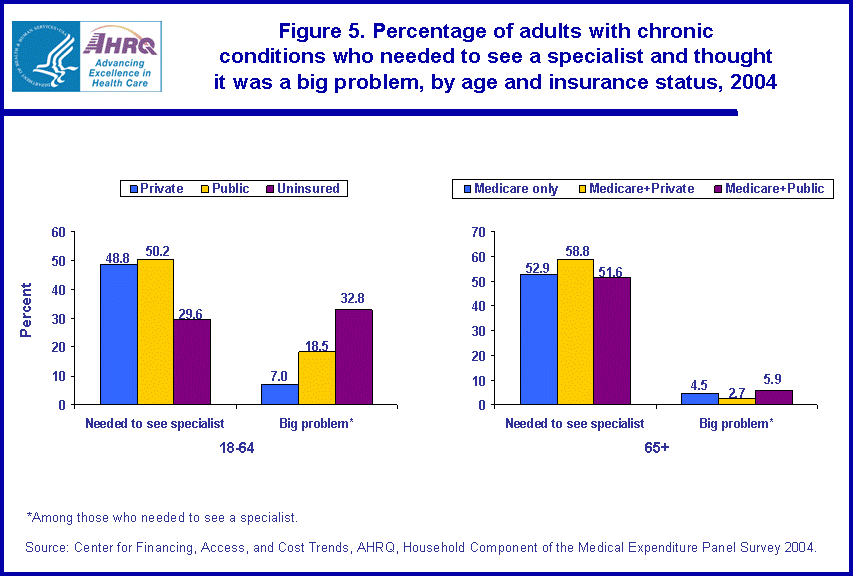
|
|
Font Size:
|
||||
|
|
|
|
||||
STATISTICAL BRIEF #162:
Getting Health Care from Specialists among Adults with Chronic Conditions, U.S. Civilian Noninstitutionalized Population, 2004
Highlights
- In 2004, half (50.0 percent) of the U.S. civilian noninstitutionalized adult population who had chronic conditions reported they or a doctor thought they needed to see a specialist in the past 12 months.
- Among adults with chronic conditions who reported they needed to see a specialist, 7.8 percent reported it was a big problem to see a specialist and 17.1 percent reported it was a small problem.
- Among adults with chronic conditions who reported they needed to see a specialist, younger adults were more likely to report it was a big problem to see a specialist than elderly adults.
- Among adults with chronic conditions who reported they needed to see a specialist, non-Hispanic blacks and Hispanics were more likely than non-Hispanic whites to report it was a big problem to see a specialist.
- Among nonelderly adults with chronic conditions who reported they needed to see a specialist, 32.8 percent of the uninsured reported it was a big problem to see a specialist compared with 7.0 percent of privately insured and 18.5 percent of publicly insured nonelderly adults with chronic conditions.
Introduction
Specialists are doctors who have completed advanced education and clinical training in a specific medical or surgical field. In 2004, more than half of the physicians in the United States were specialists, such as allergists, cardiologists, dermatologists, neurologists, oncologists, and surgeons (U.S. Census Bureau 2007). Most adults need specialty care at some time in their lives. Many adults with chronic conditions, such as ischemic heart disease or diabetes, need to see specialists more frequently than healthier adults. Persons with chronic conditions often need physicians with specialized knowledge and expertise in monitoring and treating their specific conditions (Wagner et al. 2001). Patients with complications or severe or persistent symptoms particularly need to see specialists (Katon et al. 2001). The ease with which adults with chronic conditions are able to obtain specialist care when needed is one indication of the accessibility of health care for those with greater needs (Beatty et al. 2003; Schoen et al. 2005).
Using data from the Household Component of the Medical Expenditure Panel Survey (MEPS-HC), this Statistical Brief presents estimates on the perceptions of adults with and without chronic conditions about their need for and access to physician specialists in 2004. The estimates are the opinions of the adult U.S. civilian noninstitutionalized population regarding their need to see specialists and how much of a problem it was to see a specialist. All comparisons discussed in the text are statistically significant at the .05 level unless otherwise noted.
Findings
In 2004, approximately 90 million adults had been told by a doctor that they had one or more specific chronic conditions (see Definitions section). Among those adults who had these chronic conditions, about half (50.0 percent) reported they or a doctor thought they needed to see a specialist (figure 1). In contrast, only about one-fourth (24.0 percent) of those who did not have chronic conditions perceived a need to see a specialist.
Among adults with chronic conditions who reported they needed to see a specialist, 7.8 percent reported it was a big problem to see a specialist. In this population, 17.1 percent reported it was a small problem to see a specialist as compared with 19.8 of those without chronic conditions (figure 2). Among adults with chronic conditions, 72.3 percent reported that seeing a specialist was not a problem at all as compared with 69.2 percent of those without chronic conditions.
Age
Age is strongly correlated with perceived need to see a specialist. Among those with chronic conditions, more than half (56.2 percent) of elderly adults (65+) needed to see a specialist (figure 3). In comparison, just over one-third (37.6 percent) of those in the 18-44 age group needed to see a specialist.
Among adults with chronic conditions who thought they needed to see a specialist, a higher percentage of nonelderly adults (18-44) reported it was a big problem to see a specialist than those in older age groups (45-64 or 65+) (15.3 percent versus 8.4 percent and 3.5 percent).
Race/ethnicity
Among adults with chronic conditions, a higher percentage of non-Hispanic whites reported they or a doctor thought they needed to see a specialist (52.8 percent) as compared with Hispanics and non-Hispanic blacks (44.7 percent and 37.4 percent) (figure 4). Among adults with chronic conditions who needed to see a specialist, a greater percentage of Hispanics and non-Hispanic blacks reported it was a big problem to see a specialist as compared with non-Hispanic whites (12.2 percent and 12.0 percent versus 6.4 percent).
Insurance status
Among nonelderly adults with chronic conditions, a smaller percentage of uninsured adults reported that they or a doctor thought they needed to see a specialist as compared with the adults with private insurance or public insurance (29.6 percent versus 48.8 percent and 50.2 percent) (figure 5). Despite the lower need for specialist care among the uninsured with chronic conditions, a much higher percentage reported it was a big problem to see a specialist. Among nonelderly adults with chronic conditions who needed to see a specialist, 32.8 percent of the uninsured reported it was a big problem compared with 7.0 percent of privately insured and 18.5 percent of publicly insured nonelderly adults with chronic conditions.
Among elderly adults, a higher percentage of adults who had Medicare and private insurance reported a perceived need to see a specialist as compared with those who had Medicare only or who had Medicare and additional public insurance (58.8 percent versus 52.9 percent and 51.6 percent). Among elderly adults with chronic conditions who needed to see a specialist, the percentage who thought it was a big problem did not differ significantly based on their insurance status.
Data Source
The estimates shown in this Statistical Brief are drawn from analyses conducted by the MEPS staff on the 2004 Full Year Consolidated Data public use file (HC-089).
Definitions
Chronic conditions
The indicator for chronic conditions was drawn from variables indicating presence of the following chronic conditions: arthritis, active asthma, diabetes, emphysema, high blood pressure, ischemic heart disease (coronary heart disease, angina, heart attack, or any other heart related disease), and stroke. For each of the conditions listed, the following question was asked: "(Have/Has) PERSON ever been told by a doctor or other health professional that PERSON had [condition]." For asthma, those with an affirmative answer were further asked: "(Do/Does) (PERSON) still have asthma?" In this Statistical Brief, only those with active asthma (those who answered affirmatively to the follow-up question) are included among those with chronic conditions.
Needing specialist care and access to specialists
Questions about adults' need for and access to specialists are asked annually in the MEPS adult self-administered questionnaire. These questions were taken from health plan version 3.0 of CAHPS, an AHRQ-sponsored family of survey instruments designed to measure experiences with care from the consumer's perspective. The questions ask:
Specialists are doctors like surgeons, heart doctors, allergy doctors, skin doctors, and others who specialize in one area of health care. In the last 12 months, did you or a doctor think you needed to see a specialist?
If yes: In the last 12 months, how much of a problem, if any, was it to see a specialist that you needed to see?
A big problem, A small problem, Not a problem.
More information about CAHPS can be obtained through the CAHPS Web site (http://www.cahps.ahrq.gov).
Racial and ethnic classifications
Classification by race and ethnicity is based on information reported for each family member. Respondents were asked if each family member's race was best described as American Indian, Alaska Native, Asian or Pacific Islander, black, white, or other. They also were asked if each family member's main national origin or ancestry was Puerto Rican, Cuban, Mexican, Mexicano, Mexican American, or Chicano; other Latin American; or other Spanish. All persons whose main national origin or ancestry was reported in one of these Hispanic groups, regardless of racial background, were classified as Hispanic. Since the Hispanic grouping can include black Hispanic, white Hispanic, Asian and Pacific Islanders Hispanic, and other Hispanic, the race categories of black, white, Asian and Pacific Islanders, and other do not include Hispanic. MEPS respondents who reported other single or multiple races and were non-Hispanic were included in the other category.
Health insurance status
Individuals under age 65 were classified in the following three insurance categories based on household responses to health insurance status questions:
- Any private health insurance: Individuals who, at any time during the year, had insurance that provides coverage for hospital and physician care (other than Medicare, Medicaid, or other public hospital/physician coverage) were classified as having private insurance. Coverage by TRICARE (Armed Forces-related coverage) was also included as private health insurance. Insurance that provides coverage for a single service only, such as dental or vision coverage, was not included.
- Public coverage only: Individuals were considered to have public coverage only if they met both of the following criteria: 1) they were not covered by private insurance at any time during the year, and 2) they were covered by one of the following public programs at any point during the year: Medicare, Medicaid, or other public hospital/physician coverage.
- Uninsured: The uninsured were defined as people not covered by private hospital/physician insurance, Medicare, TRICARE, Medicaid, or other public hospital/physician programs at any time during the entire year or period of eligibility for the survey.
- Medicare only: Individuals who, at any time during the year, were covered by Medicare only. For analytic purposes, this classification also includes a very small number of persons ages 65 and over who did not report Medicare coverage.
- Medicare plus private (including TRICARE): Individuals who at any time during the year, were covered by a combination of Medicare, TRICARE or private insurance.
- Medicare plus other public coverage: Individuals who, at any time during the year, were covered by Medicare in addition to some other type of public insurance.
About MEPS-HC
MEPS-HC is a nationally representative longitudinal survey that collects detailed information on health care utilization and expenditures, health insurance, and health status, as well as a wide variety of social, demographic, and economic characteristics for the civilian noninstitutionalized population. It is cosponsored by the Agency for Healthcare Research and Quality and the National Center for Health Statistics.
For more information about MEPS, call the MEPS information coordinator at AHRQ (301-427-1656) or visit the MEPS Web site at http://www.meps.ahrq.gov/.
References
For a detailed description of the MEPS survey design, sample design, and methods used to minimize sources of nonsampling error, see the following publications:
Cohen, J. Design and Methods of the Medical Expenditure Panel Survey Household Component. MEPS Methodology Report No. 1. AHCPR Pub. No. 97-0026. Rockville, Md.: Agency for Health Care Policy and Research, 1997.
Cohen, S. Sample Design of the 1996 Medical Expenditure Panel Survey Household Component. MEPS Methodology Report No. 2. AHCPR Pub. No. 97-0027. Rockville, Md.: Agency for Health Care Policy and Research, 1997.
Cohen, S. Design Strategies and Innovations in the Medical Expenditure Panel Survey. Medical Care, July 2003: 41(7) Supplement: III-5-III-12.
For more information about specialists and care for people with chronic conditions, see the following publications:
Beatty, P. W., K. J. Hagglund, M. T. Neri, K. R. Dhont, M. J. Clark, and S. A. Hilton. Access to health care services among people with chronic or disabling conditions: patterns and predictors. Archives of Physical Medicine and Rehabilitation, October 2003, 84(10):1417-25.
Katon, W., M. Von Korff, E. Lin, and G. Simon. Rethinking practitioner roles in chronic illness: the specialist, primary care physician, and the practice nurse. General Hospital Psychiatry, May-June 2001, 23(3): 138-144.
Schoen, C., R. Osborn, P. H. Huynh, M. Doty, K. Zapert; J. Peugh, and K. Davis. Taking the pulse of health care systems: experiences of patients with health problems in six countries. Health Affairs, July-December 2005, Supplement Web Exclusives:W5-509-25.
U.S. Census Bureau. Statistical Abstract of the United States: 2007. (126th Edition) Washington, DC, 2005.
Wagner, E. H., B. T. Austin, C. Davis, M. Hindmarsh, J. Schaefer, and A. Bonomi. Improving chronic illness care: translating evidence into action. Health Affairs, November-December 2001, 20(6):64-78.
Suggested Citation
Soni, A. and Hill, S. C. Getting Health Care from Specialists among Adults with Chronic Conditions, U.S. Civilian Noninstitutionalized Population, 2004. Statistical Brief #162. February 2007. Agency for Healthcare Research and Quality, Rockville, Md. http://www.meps.ahrq.gov/mepsweb/data_files/publications/st162/stat162.shtml
AHRQ welcomes questions and comments from readers of this publication who are interested in obtaining more information about access, cost, use, financing, and quality of health care in the United States. We also invite you to tell us how you are using this Statistical Brief and other MEPS data and tools and to share suggestions on how MEPS products might be enhanced to further meet your needs. Please e-mail us at mepspd@ahrq.gov or send a letter to the address below:
Steven B. Cohen, PhD, Director
Center for Financing, Access, and Cost Trends
Agency for Healthcare Research and Quality
540 Gaither Road
Rockville, MD 20850
 |
||||||||||||||||||||||||||||||||||||
|
||||||||||||||||||||||||||||||||||||
|
|
||||||||||||||||||||||||||||||||||||
 |
||||||||||||||||||||||||||||||||||||
|
||||||||||||||||||||||||||||||||||||
|
|
||||||||||||||||||||||||||||||||||||
 |
||||||||||||||||||||||||||||||||||||
|
||||||||||||||||||||||||||||||||||||
|
|
||||||||||||||||||||||||||||||||||||
 |
||||||||||||||||||||||||||||||||||||
|
||||||||||||||||||||||||||||||||||||
|
|
||||||||||||||||||||||||||||||||||||
 |
||||||||||||||||||||||||||||||||||||
|
||||||||||||||||||||||||||||||||||||
|
|
||||||||||||||||||||||||||||||||||||


